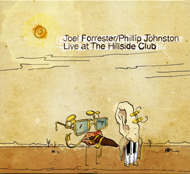Joel Forrester/Phillip Johnston
Live At The Hillside Club
(Asynchronous Records)
It's
quite strange to have "co-leaders of The Microscopic Septet" as
still the best tag at one's disposal when it comes to succinctly describe
two musicians who have done quite a lot, in a lot of quite diverse contexts,
in careers by now spanning several decades. Stranger still, if one considers
that The Micros' "fame" when it comes to the "general audience"
is quite small - several orders of magnitude smaller than the critical kudos
The Micros have received for their work - and barely enough to have them
filed under the "cult groups" category.
But
this time, for once, I have no reason to feel guilty. Sure, the relationship
between pianist Joel Forrester and saxophonist (mostly soprano) Phillip
Johnston (both, it goes without saying, are quite prolific composers) predates
the start of the septet, the same being true of the love both men share
when it comes to the music of pianist/composer Thelonious Monk. But without
The Micros this CD would not exist: in fact, Live At The Hillside Club
was recorded during a brief tour of the (USA) West Coast while the duo
was promoting the fine album called Friday the
Thirteenth - The Micros Play Monk.
Monk's
presence is sometimes literal, four Monk compositions being featured here:
Well You Needn't, Pannonica, Evidence, and Epistrophy. Attentive listeners
will have great fun trying to detect his influence on those compositions
penned by Johnston (one) and Forrester (seven, the duo's building blocks
appear for the most part to be his). Listening to this album also means
listening to a musical partnership that - the specific compositions notwithstanding
('cause these are compositions with very specific demands we are talking
about, not
"heads") - lives "in the moment", the satisfaction on
the part of the players being at times quite palpable: check Forrester's "Yeah!"
after a very fast unison, skillfully executed, on Your Little Dog (at about
6' 11"); or Forrester's suggestion - "Let's Play Together!" -
a few seconds after another satisfied "Yeah!" (at about 6' 16")
on Pannonica.
The
album was recorded and mixed very well (by Bruce Koball). I don't know
whether my personal impression of being right there on stage, sitting between
the piano and the soprano music stand, was due to my having listened to
this album on headphones on a (quality) portable CD player (the laser of
my CD player #1 being in need of a check). In any case, one can easily
hear Forrester's foot starting the pieces, those "Yeah!"s, and
also some la-di-da. The only thing that's impossible to hear is... the
audience!, I mean, the audience applauding at the end of the pieces. There
sure is an audience - somebody coughs! So when - almost at the end of the
album - there is applause, at last (between I Know What Girls Like and
Epistrophy) it's almost like the audience managed to untie themselves from
the ropes that held them captive. (Is it really
"Sbagliato!" the word somebody shouts at about 3'18" in I
Know What Girls Like?)
As
it's to be expected when it comes to these particular players, the music
is quite diverse. A couple themes - first track Bunny Boy, also Loser's
Blues - reminded me of Charles Mingus (try adding a muted trumpet to both
themes). There's a pinch of quasi-Minimalism: check Second Nature, for
solo piano, in 11/8, which Forrester describes as being a cross between
Charles Ives and Herbie Nichols; also the piano solo - a "lock-handed
counterpoint" - on Epistrophy. There's the Spiritual touch of Did
You Ever Want To Cry (which reminded me a bit of Wayne Horvitz, and which
would be perfect for an album by Charlie Haden's Liberation Music Orchestra).
There's a track for soprano solo - Splat - with an arpeggiated fragment
which to me sounds like having
"Latin" accents. There are instances where the left hand on the
piano perfectly impersonates a "walking bass" (Bunny Boy, Evidence),
or the soprano sax impersonates a very Ellington-sounding reed section backing
the piano (Bunny Boy, Well You Needn't).
Talking
about the whole picture, it's good to see both men dealing with many different
climates while at the same time never sounding "generic". Attentive
listening sessions will reveal the intricate routes hidden under the surface
of Johnston's relaxed performances.
Alas!,
though this is not a "difficult" album, it's a quite subtle piece
of work, which in today's world can only signal "commercial death".
There are useful liner notes, and elegant visuals by Vera Varlamova. Another
bull's eye for Asynchronous Records!
Beppe Colli
© Beppe Colli 2011
CloudsandClocks.net | Oct. 23, 2011











